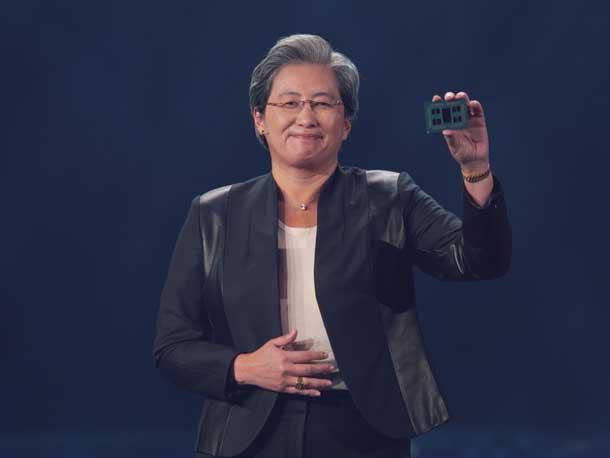AMD Claims Big Uptake In ‘AI Engagements’ As Server, PC Chip Slowdown Persists
Lisa Su, AMD’s CEO, says the chip designer’s AI customer engagements around its Instinct data center accelerators ‘grew by more than seven times’ in the second quarter, another sign that companies are looking for alternatives to Nvidia’s popular GPUs after Intel reported a similar increase in its AI customer pipeline last week.

AMD CEO Lisa Su said the chip designer has “significantly” expanded engagements with customers on AI opportunities against a continued slowdown in sales for its server and PC chips.
The chief executive disclosed the momentum in AI customer interest around what she called AMD’s “broad portfolio” of “leadership GPUs, CPUs and adaptive computing solutions for AI inferencing and training” in the Tuesday earnings call for the company’s second quarter, which ended July 1.
[Related: AMD Hires Ex-Arrow Exec Mark Taylor As North America Channel Chief]
Su’s comments about AI engagements focused on AMD’s data center accelerators: the Instinct MI250 GPU from 2021 and its upcoming Instinct MI300 chips that it has teased as formidable competitors to the popular H100 data center GPU from Nvidia, which currently dominates the AI computing market.
“AI customer engagements grew by more than seven times sequentially as multiple customers initiated or expanded programs supporting future deployments of Instinct MI250 and MI300 hardware and software at scale,” she said.
Intel, AMD’s largest rival by revenue, reported last week that its customer pipeline for AI-optimized chips grew about six times in the second quarter—mainly around its Gaudi deep learning processors—another sign that companies are looking for alternatives to Nvidia’s popular data center GPUs.
Su said the CPU-GPU hybrid MI300A and the GPU-only MI300X are sampling now with “leading” customers in the high-performance computing, cloud and AI segments. A “number of customers” are “committed” to buy MI300 chips beyond the U.S. Department of Energy, which plans to use the MI300A for its upcoming exascale supercomputer, El Capitan, she added later in the call.
The MI300 chips are part of a data center accelerator market that AMD expects will become a more than $150 billion opportunity by 2027, according to Su.
But the company also sees AI as a “significant demand PC demand driver,” Su added, due to Microsoft and other large software providers that plan to take advantage of its “multi-generational Ryzen AI processor road map,” which starts this year with the Ryzen 7040 CPU lineup for laptops.
AMD believes there’s a substantial opportunity to address AI applications with chips designed for edge and embedded devices as well.
“While we are still in the very early days of the new era of AI, it is clear that AI represents a multi-billion dollar growth opportunity for AMD across cloud, edge and an increasingly diverse number of intelligent endpoints,” Su said.
Slowdown Continues For Data Center, PC Chip Sales
AMD made clear its bullishness about the company’s future AI opportunities as the chip designer continued to experience a slowdown in sales for its data center and PC chips.
For the second quarter, the chip designer reported revenue of $5.4 billion, the same amount it generated in the previous quarter and down 18 percent year-over-year.
This dragged down the company’s gross profit by 25 percent to $2.6 billion and gross margin by 4 points to 50 percent when not using generally accepted accounting principles. Earnings per share were down 45 percent to 58 cents per share on a non-GAAP basis.
However, AMD’s revenue and net earnings surpassed the expectations of financial analysts. In turn, AMD’s stock price went up more than 3 percent in after-hours trading Tuesday.
The biggest drag on AMD’s second-quarter revenue was the client CPU segment, which brought in $998 million, down 54 percent year-over-year due to what the company said was “reduced processor shipments from a weaker PC market and a significant inventory correction across the PC supply chain.”
The silver lining in AMD’s client revenue was that it had increased 35 percent from the previous quarter due to significant growth in sales for its Ryzen 7000 CPU, a sign of recovery for the PC market.
The chip designer’s data center segment also saw a revenue decline, 11 percent year-over-year to $1.3 billion, due to “soft” enterprise demand and “elevated” inventory levels at cloud service providers. Revenue did, however, increase sequentially to the tune of 2 percent, as the company reported nearly a doubling in fourth-gen EPYC CPU revenue and EPYC CPU sales to enterprise customers.
AMD’s gaming revenue, on the other hand, only contracted by 4 percent year-over-year to $1.6 billion, with lowering GPU sales more than offsetting semi-custom revenue.
The only area where AMD grew was the embedded segment, which brought in $1.5 billion, a 16 percent increase from the same period last year. At the same time, this represented a 7 percent decline sequentially, which AMD said was mainly due to “softness” in the communications market.
For the third quarter, AMD expects to bring in $5.7 billion in revenue, plus or minus $300 million, with a non-GAAP gross margin of approximately 51 percent.
Su said the company believes seasonal growth in the PC market will contribute to this while AI-related customer wins are expected to offset softness in the data center.
“I think we have an opportunity to address a large portion of that [AI] market,” she said. “So that makes it a very clear priority for us. It’s our No. 1 strategic priority, and we’ll continue to work closely with our customers as they optimize between CPU and GPU spend.”